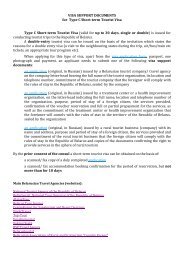Human Development Report 2013 - UNDP
Human Development Report 2013 - UNDP
Human Development Report 2013 - UNDP
Create successful ePaper yourself
Turn your PDF publications into a flip-book with our unique Google optimized e-Paper software.
Statistical acknowledgementsThe <strong>Report</strong>’s composite indices and other statistical resourcesdraw on a wide variety of the most respected internationaldata providers in their specialized fields. We are particularlygrateful to the Carbon Dioxide Information Analysis Centerof the US Department of Energy; Centre for Research on theEpidemiology of Disasters; Eurostat; Food and AgriculturalOrganization; Gallup; ICF Macro; International EnergyAgency; International Labour Organization; InternationalMonetary Fund; International Telecommunication Union;International Union for Conservation of Nature; Inter-ParliamentaryUnion; Luxembourg Income Study; Organisation forEconomic Co-operation and <strong>Development</strong>; Stockholm InternationalPeace Research Institute; United Nations Children’sFund; United Nations Conference on Trade and <strong>Development</strong>;United Nations Department of Economic and Social Affairs;United Nations Economic Commission for Latin America andthe Caribbean; United Nations Educational, Scientific andCultural Organization Institute for Statistics; United NationsOffice on Drug and Crime; United Nations World TourismOrganization; World Bank; World Health Organization; andWorld Intellectual Property Organization. The internationaleducational database maintained by Robert Barro (HarvardUniversity) and Jong-Wha Lee (Korea University) is anotherinvaluable source for the calculation of the <strong>Report</strong>’s indices.Statistical tablesThe first five tables contain the composite human developmentindices and their components; the remaining nine tables presenta broader set of indicators related to human development.Four composite human development indices—the <strong>Human</strong><strong>Development</strong> Index (HDI), the Inequality-adjusted <strong>Human</strong><strong>Development</strong> Index (IHDI), the Gender Inequality Index(GII) and the Multidimensional Poverty Index (MPI)—havebeen presented since the 2010 <strong>Human</strong> <strong>Development</strong> <strong>Report</strong>.The GII and the MPI remain experimental indices.HDI values along with values of the four component indicatorson life expectancy, educational attainment and incomeare presented in table 1. Countries are ranked according toHDI value. The difference between rank by gross nationalincome and HDI indicates whether a country is efficientlyusing its income for advancement in the two nonincome HDIdimensions. The nonincome HDI is calculated to provide anadditional means of cross- country comparison and to ordercountries by achievements in the nonincome dimensions.A time series of HDI values based on data available in 2012,thus using the most recent revision of historical data andmethodology, is presented in table 2. It is the only means forcomparing HDI values for 2012 with those for past years. Thechange in HDI rank over the last five years and between 2011and 2012 as well as the average annual HDI growth rate acrossfour time periods allow for easy assessment of the direction andspeed of HDI changes.Table 3 presents the IHDI, which goes beyond a country’saverage achievements in health, education and income toshow how the achievements are distributed among residentsby discounting the value of each dimension according to itslevel of inequality. The IHDI can be interpreted as the actuallevel of human development (accounting for inequality), whilethe HDI is the potential human development that could beobtained if achievements were distributed equally among residents.The difference between the HDI and IHDI, expressed asa percentage, defines the loss in potential human developmentdue to inequality. The difference in ranking by the HDI andthe IHDI indicates that taking inequality into account wouldeither lower a country’s rank (negative value) or improve it(positive).Table 4 presents the Gender Inequality Index, an experimentalcomposite measure of inequality in achievement betweenwomen and men in three dimensions: reproductive health,empowerment and the labour market. The GII is designed toprovide empirical foundations for policy analysis and advocacyefforts. A high value indicates high inequality between womenand men.The Multidimensional Poverty Index, an experimental measuredesigned to capture the overlapping deprivations that peopleface in education, health and living standards, is presented intable 5. The MPI gives both the incidence of nonincome multidimensionalpoverty (a headcount of those in multidimensionalpoverty) and its intensity (the relative number of deprivationspeople experience at the same time). The contributions of deprivationsin each dimension to overall poverty are included toprovide a comprehensive picture of people living in poverty.Countries are presented alphabetically in two groups accordingto the year of the survey used to estimate the MPI.Table 6 combines macroeconomic indicators such as grossdomestic product (GDP), gross fixed capital formation and theconsumer price index with public spending indicators. Duringeconomic uncertainty or recession, gross fixed capital formationtypically declines. The consumer price index is presented asa measure of inflation. Indicators of public spending are givenfor two points in time to allow for analysis of change in spending.These indicators can be used to examine priorities in publicspending and the pattern of expenditure and how it relates tohuman development outcomes.Several indicators on the health of children, youth and adultsas well as two indicators of health care quality are presentedReaders guide | 141
















